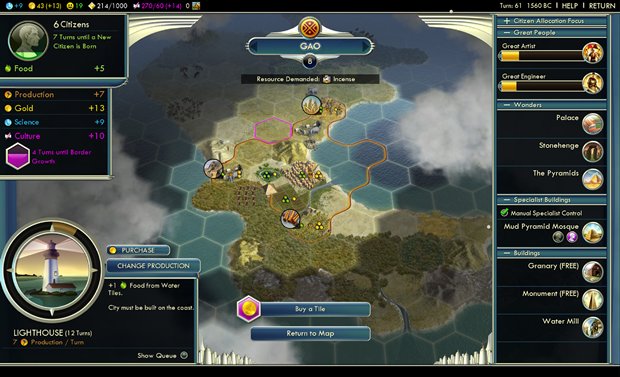Civilization V offers its lovely world to be ravaged in our hands-on
Never before have colonization, expansion, and conquest been so inviting
Large, connected formations of units also mean that defending your territory becomes more interesting, as a small gap in your defenses won’t mean an entire army can just waltz through. Of course, sitting your army inside your territory will leave you behind – especially with the introduction of City States. These smaller, autonomous and always AI-controlled territories mix things up for the larger empires. In our game, a nearby City State asked for a barbarian stronghold near them to be cleared out. We dragged our feet a bit, and when we finally arrived, we’d found that another empire had taken care of the problem first, granting them the favor of the City State and leaving us at a disadvantage.
The AI in general has more personality now – the first few rulers we met were fairly gracious, but then when we met Caesar, he was arrogant and demanding. It didn’t take us long to piss him off, and we weren’t trying. Luckily, the player now has an entire host of advisors. When you’re contemplating what to research next, recommended technologies will have icons next to them indicating which advisor recommends what. So if you’re worried about your defenses, listen to the military advisor. Of course, experienced Civ players will follow their own paths to dominance, but it’s a nice extra layer to help out the newbies, and adds a bit of information for even shrewd strategists to use when uncertain of a particular course.

Above: Diplomacy is more complex now, with shared research and City States adding more opportunities for collaboration... and more chances to backstab
It would be odd to see any sequel that doesn’t improve on the visual front, and Civ V certainly accomplishes this, even if it’s not a massive face-lift. Or, more accurately, it’s not a massively obvious upgrade. The changes lie in the small details. Puffs of smoke as cannon and rifles fire, the crisp textures of simple mountain and field tiles, and the glittering shimmer of the Sun’s reflection on the ocean waves all add up to a pleasing visual palette. The fog of war is even literally fog – and the billowing swaths look damn good. Combine the purely higher detail graphics with an uncluttered interface and you’ve got a Civ game that tingles the senses while getting out of the way to let your brain focus on strategy.

Above: Zooming in reveals intricate unit details
We found the transition from Civ IV to be quite easy despite the considerable interface changes. We’re sure that some hardcore Civ fans will find things to grumble about – but we’re betting these grumbles will fade once the ease-of-use settles in. We didn’t get a chance to get stomped in multiplayer (and we would get stomped), so we don’t yet know how all these changes will play out in the online arena. We’re also not sure if all the little changes will add up to something players will consider worthy of a full-sequel, since these are the types of things that need time for the community to play with and discover how much deeper the series has truly gotten. Either way, Civ V still proves to be a time-compressor – those three hours of hands on time were over before we were ready to stop playing.
Aug 5, 2010
Weekly digests, tales from the communities you love, and more



